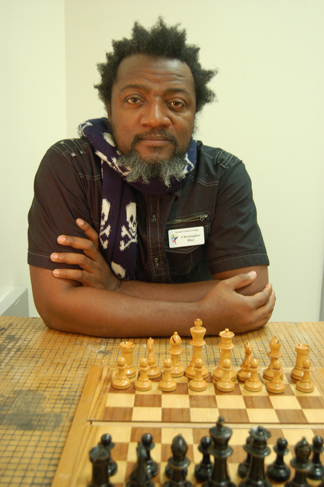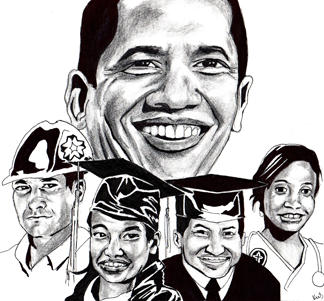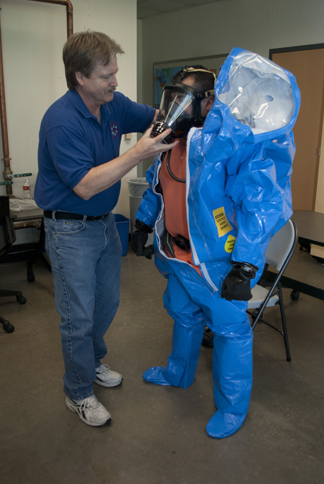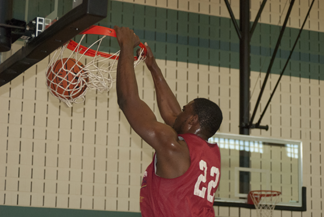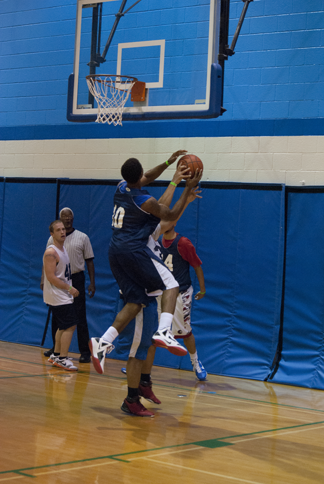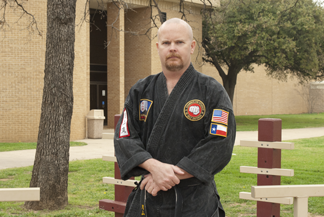By Karen Gavis/se news editor
Today it is green tea. But more often, coffee is the silent companion of a man as unique as the art that surrounds him.
In an obscure, dimly lit office just behind SE Campus Art Corridor ll, he gazes at images of paintings on the computer as he prepares the next exhibit. A smooth, bare wooden model resembling a featureless doll and missing a left foot rests against a wall while Spanish classical music wafts through the silence.
Meet curator and instructional assistant Christopher Blay, whose typical day may include calling artists, looking online to determine upcoming art exhibits, planning future exhibits and assisting in the Macintosh lab. Occasionally, he can be seen picking up trash in the art corridor.
“My philosophy about curating is trying to find a way to communicate, in a non-academic way, art that exists in an institution,” he said.
When preparing for an exhibit, Blay’s method is pretty straightforward. He will usually view images first, then follow up with a studio visit to get a sense of which pieces will work and what ideas the exhibit will explore, he said.
Part of his job is putting an artist’s work into context. In doing so, he proposes a theme and then places either an artist’s or a combination of artists’ work around that theme.
Most of the work in the art corridor comes from working artists with a national or international connection to the arts, Blay said. However, Art Corridor l is primarily used to exhibit the work of emerging TCC artists.
Blay’s main goal, he said, is to expose students to the possibilities of what art can be while complementing what they are learning in their studio classes.
A broader goal is to continue the strong TCC tradition of being part of a greater art community.
“I look for ideas and contexts that are complex enough to give you pause and accessible enough to elicit a genuine response,” he said. “Art is about ideas. We communicate at a deeper level when we try to streamline our ideas and ourselves into images and objects that can’t themselves give a literal and direct reference to our deeper selves.”
Blay not only curates the art of others, but he creates and exhibits his own art as well. Moreover, he created the Haltom City Stories Project, which, according to his blog, was conducted last fall and preserved some Haltom City residents’ memories on video.
“I’m an installation artist, and my work is primarily a response to philosophical issues in photography and the nature of images and image-making in a world of increasingly mediated experiences,” he said.

Georgia Phillips/The Collegian
A few of the artists Blay admires are Robert Rauschenberg, Anselm Kiefer and Richard Tuttle. While there have been many great eras of art, when pinpointing a particular era that attracts him, Blay favors German Expressionism.
“In the context of the time it was created, it was a very strong departure from what had come before. It was very dramatic,” he said.
A former TCC student, Blay graduated from Texas Christian University with a degree in fine arts. He studied with the late Peter Feresten, whose work is currently on exhibit in Art Corridor ll.
“Peter and Richard [Doherty, NE photography associate professor] were kind of my first introduction into art,” he said.
Doherty said Blay was a productive and creative student whose solutions to visual problems Doherty assigned him were thoughtful and philosophical in nature. As a result, he became a role model in his foundation photography classes and the department in general.
“It is always a pleasure to have students like Chris who challenge traditions and push their art to the next level,” he said.
Blay said he began working with conceptual and installation art a few years after graduating from TCU. He does not see himself doing anything else besides working in the fine arts.
“I think art is my career,” he said. “I will be making things and doing things and putting things together as long as ever.”
Blay’s children are artistic as well. Kera, 21, is a graduating college senior majoring in theater. Christie, 13, acts and sings and has won a medal for her drawings while Aaron, 19, is into music.
Although not a follower of trends, Blay thinks the trends toward electronic art raise some important philosophical questions. For instance, what is classified as art?
“The thing that sticks to the wall is what art is,” he said.
SE director of dual credit, career and campus services Michael Cinatl said Blay’s eye for color and composition are stellar. Additionally, he is one of the most easygoing and team-oriented individuals he has ever worked with.
Others agree.
“He’s great to work with,” said fine arts chair Gregory Dewhirst. “He’s pretty laid-back.”
And as he sits perusing art, tea steeping to the sound of Manuel de Falla, it appears so.

























